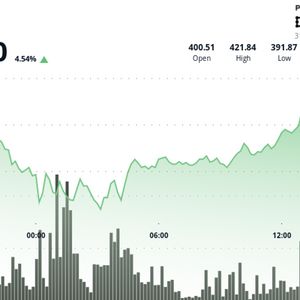BitcoinWorld Ethereum Price Prediction: Arthur Hayes Forecasts Astonishing $5K Target This Year The world of cryptocurrency is always buzzing with predictions, and when figures like Arthur Hayes, the co-founder of BitMEX, speak, the market listens. Hayes recently shared a bold Ethereum price prediction that has caught the attention of investors and enthusiasts alike, suggesting that ETH could climb significantly by the end of 2024. Arthur Hayes’ Bold Ethereum Price Prediction: Why $5,000? In a recent interview with Decrypt at the Bitcoin 2025 conference in Las Vegas, Arthur Hayes laid out his bullish case for Ethereum. He posited that ETH price could potentially reach between $4,000 and $5,000 before the year is out. This isn’t just a random guess; Hayes bases his prediction on a specific market thesis. According to Hayes, Ethereum currently holds the title of the “most hated” Layer-1 blockchain . This might sound counterintuitive for the second-largest cryptocurrency by market cap, but Hayes argues that assets that are currently out of favor or heavily criticized often deliver the best returns when market sentiment shifts and Crypto market cycles turn positive. His view is that this contrarian dynamic is setting the stage for Ethereum to potentially outperform other assets in the near future. Is Ethereum Truly the “Most Hated” Layer-1 Blockchain? Hayes’ characterization of Ethereum as the “most hated” L1 is certainly provocative. While Ethereum boasts a massive ecosystem, unparalleled developer activity, and the lion’s share of DeFi and NFT markets, it has faced significant criticism over the years. Why might someone like Hayes see it this way? Here are some potential reasons often cited by critics: High Gas Fees: Although improved by Layer-2 solutions and upgrades, periods of high network activity can still lead to exorbitant transaction costs on the mainnet, pricing out smaller users. Scaling Challenges: While progress is being made with Ethereum 2.0 (now the Consensus Layer) and Layer-2s, full scaling solutions are still under development and adoption can be fragmented. Regulatory Uncertainty: Ethereum’s transition to Proof-of-Stake has raised questions from regulators, particularly in the U.S., about its potential classification as a security. Competition: A multitude of newer, faster, and cheaper Layer-1 blockchains (often dubbed “Ethereum Killers”) have emerged, attracting users and developers away from Ethereum. Narrative Fatigue: Compared to the fresh narratives around newer chains or specific niches like AI or gaming tokens, Ethereum’s ongoing development might feel less exciting to some market participants focused on short-term gains. Hayes likely sees this collective criticism and perceived lack of mainstream enthusiasm compared to the hype surrounding newer assets as indicators of it being currently undervalued or overlooked based on its fundamental strengths. Understanding Crypto Market Cycles and the “Hated Asset” Phenomenon Arthur Hayes’ thesis heavily relies on the cyclical nature of the crypto market and the historical tendency for assets that were previously dismissed or unpopular to rally strongly. Crypto markets don’t move in a straight line; they experience boom and bust cycles driven by speculation, technological developments, regulatory news, and shifting narratives. Historically, we’ve seen this play out with various assets. Bitcoin itself was once dismissed as “rat poison” by prominent figures. Other altcoins that were left for dead after previous market crashes have seen massive resurrections in subsequent bull runs. The idea is that when an asset is widely disliked or ignored, selling pressure is low, and any positive catalyst or general market upturn can lead to a rapid price increase as buyers face little resistance. Hayes suggests that Ethereum, despite its foundational importance, is currently in a phase where it’s not the market darling. This, in his view, makes it a prime candidate for a significant upward move once the broader Crypto market cycles continue their positive trajectory. Factors Fueling Potential ETH Price Growth While Hayes’ “hated asset” thesis is based on market psychology and cycles, there are also fundamental developments within the Ethereum ecosystem that could support a move towards his $4,000-$5,000 target: Dencun Upgrade Impact: The recent Dencun upgrade significantly reduced transaction costs on Layer-2 networks, making the Ethereum ecosystem more accessible and usable. This could drive increased adoption and activity. Staking Yields: With the transition to Proof-of-Stake, users can earn yield by staking ETH. This provides an incentive to hold ETH and reduces the circulating supply available on exchanges. DeFi and NFT Dominance: Despite competition, Ethereum still hosts the vast majority of decentralized finance (DeFi) and non-fungible token (NFT) activity by value, underpinning its continued relevance. Potential Spot ETH ETF: Speculation and potential approval of a spot Ethereum Exchange-Traded Fund (ETF) in major markets like the U.S. could unlock significant institutional demand, similar to what was seen with Bitcoin ETFs. Ecosystem Development: Ongoing innovation in Layer-2 scaling, decentralized applications (dApps), and infrastructure continues to build value on top of the Ethereum base layer. These factors, combined with a favorable macroeconomic environment and positive overall sentiment in Crypto market cycles , could provide the necessary momentum for ETH price to reach Hayes’ predicted levels. Potential Headwinds and Challenges for Ethereum It’s crucial to consider that Hayes’ prediction is not guaranteed. Several factors could act as headwinds or prevent Ethereum from reaching the $5,000 mark this year: Regulatory Action: Increased regulatory scrutiny or adverse rulings, particularly regarding ETH’s status, could negatively impact sentiment and price. Macroeconomic Factors: Broader economic downturns, rising interest rates, or global instability can dampen investor appetite for risk assets like crypto. Competition: Other Layer-1 blockchains continue to innovate and capture market share, potentially limiting Ethereum’s growth. Execution Risks: Delays or issues with future Ethereum upgrades could impact confidence. Market Sentiment Shifts: If the overall crypto market experiences a significant downturn, even a fundamentally strong asset like ETH would likely be affected. What This Ethereum Price Prediction Means for Investors Arthur Hayes’ prediction serves as a bullish outlook based on a specific market thesis. For investors, it highlights the potential upside in Ethereum, especially if the “hated asset” narrative plays out and fundamental strengths are recognized by the market. However, it’s essential to remember that price predictions, especially in the volatile crypto market, are speculative. Investors should conduct their own research, understand the risks involved, and consider diversifying their portfolios. Hayes’ analysis provides a valuable perspective, but it’s just one voice among many in a complex market. Conclusion Arthur Hayes’ forecast of Ethereum reaching $4,000-$5,000 this year is rooted in his belief that ETH is currently an undervalued asset, overlooked by the market and positioned to benefit as Crypto market cycles evolve. His “most hated” Layer-1 blockchain thesis, combined with ongoing fundamental developments within the Ethereum ecosystem, presents a compelling case for potential significant price appreciation. While challenges and market volatility remain, Hayes’ prediction adds to the growing optimism surrounding Ethereum’s prospects in 2024. To learn more about the latest explore our article on key developments shaping Ethereum price action. This post Ethereum Price Prediction: Arthur Hayes Forecasts Astonishing $5K Target This Year first appeared on BitcoinWorld and is written by Editorial Team



















